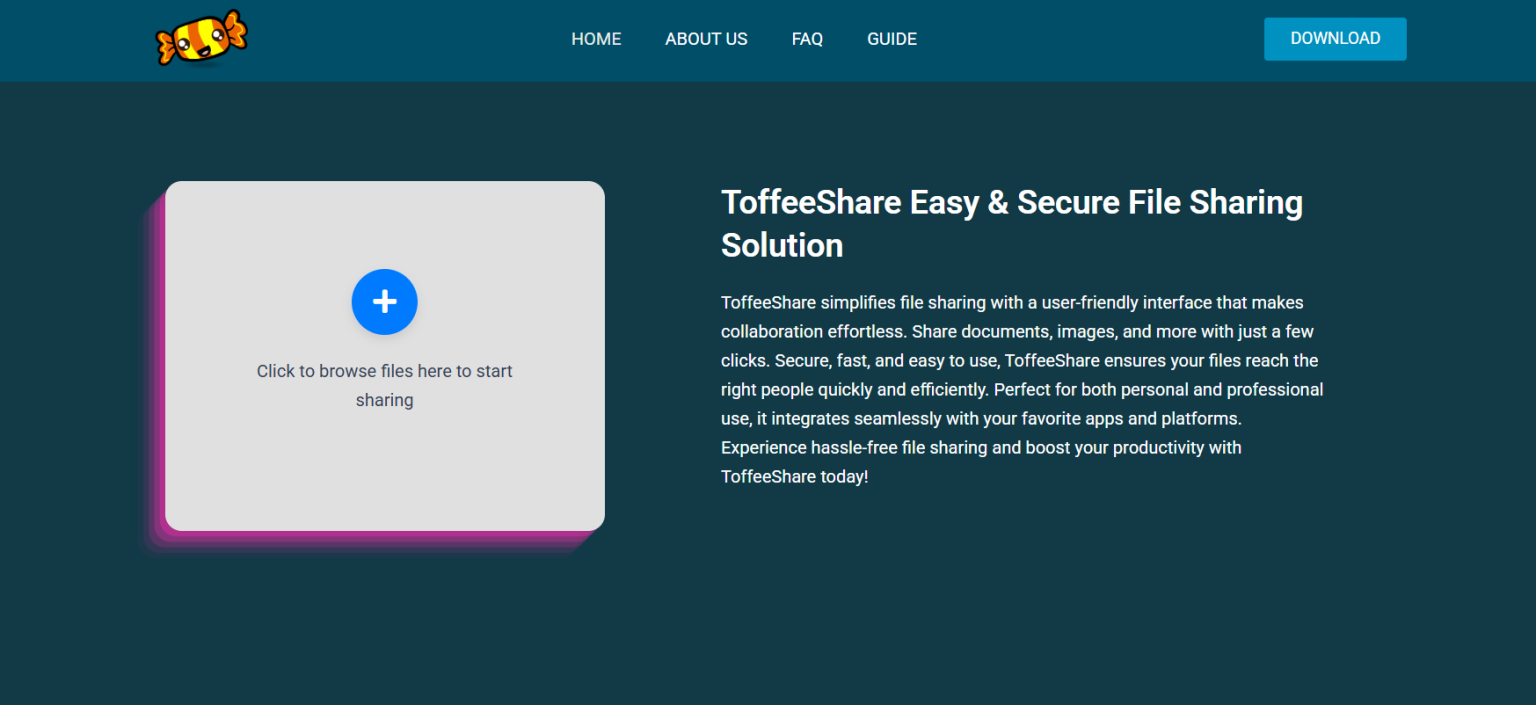In an age where digital content continues to grow at an exponential rate, data storage and transfer solutions are more vital than ever. People are constantly sharing large files for work, education, entertainment, and collaboration. Traditional cloud storage services like Google Drive, Dropbox, and OneDrive have long been the go-to options. However, a newer alternative, ToffeeShare, has emerged with a different philosophy—offering direct, encrypted, peer-to-peer file transfers with no storage in the cloud.
Understanding how ToffeeShare works, its advantages and limitations, and comparing it with popular cloud storage solutions reveals a deeper picture of what modern users need from file-sharing technologies. As digital demands evolve, so do the tools we use. ToffeeShare is not just another file transfer utility—it represents a fundamentally different approach to digital communication and file exchange.
The Philosophy Behind ToffeeShare
ToffeeShare operates on a peer-to-peer (P2P) basis, similar to how torrenting technology works. This means files are transferred directly from sender to receiver without being stored on an intermediary server. Unlike cloud-based services, where files are uploaded to a centralized storage space and then downloaded by the recipient, ToffeeShare creates a secure tunnel between two devices in real time.
This model bypasses traditional data storage concerns. Since files are never uploaded to a third-party server, there is no lingering digital footprint, significantly enhancing privacy and security. ToffeeShare also implements end-to-end encryption and WebRTC technology, ensuring that the shared files are not intercepted or tampered with during transit.
Performance and Speed
Performance is one of the most significant advantages ToffeeShare holds over cloud storage platforms. In cloud environments, file transfers often depend on the upload and download speed of both the sender and recipient, but the server load and regional availability also constrain them. Uploading large files to cloud storage, especially over slower connections, can be time-consuming and inefficient.
ToffeeShare eliminates the upload bottleneck by enabling direct transfers. As long as both parties are online and connected, data is transferred as fast as the slowest internet connection between them allows. In practice, this can make large file transfers significantly quicker, particularly on local networks or between users in close geographic proximity.
This approach also reduces latency, making it ideal for transferring high-resolution media, software packages, or sensitive documents quickly and securely.
Security and Privacy Considerations
Cloud storage services, while offering convenience and large storage capacities, also introduce privacy risks. Files stored in the cloud are potentially vulnerable to breaches, hacks, or data mining—even when encrypted. While companies like Google and Microsoft invest heavily in data security, users still need to trust them with sensitive information.
ToffeeShare changes the trust model. Since no files are stored on third-party servers, the risk of mass data breaches is practically eliminated. The platform uses state-of-the-art encryption protocols to ensure that only the intended recipient can access the data. Once the transfer is complete, the connection is closed, and no copy of the file remains anywhere else.
This peer-to-peer model appeals strongly to users concerned about surveillance, data sovereignty, or third-party access to their files. Journalists, researchers, and privacy advocates particularly benefit from such a setup.
Ease of Use and Accessibility
User experience is an area where cloud services typically shine. They offer sleek user interfaces, mobile apps, automatic syncing, and multi-device access, which make them convenient for everyday users. They also allow for version control, collaboration tools, and file recovery features.
ToffeeShare, in contrast, is more minimalistic. It runs directly in the browser without requiring any registration, installation, or login. The simplicity is one of its strengths. Users simply open the website, drop a file, and share the link or QR code with the recipient. However, the requirement that both users remain online simultaneously can be a limitation in scenarios where asynchronous sharing is needed.
The lack of storage also means there’s no history or archive of previously sent files. This can be both a feature and a limitation depending on the user’s needs. While it enhances privacy, it also removes the convenience of retrieving old files without resending.
Scalability and Collaboration
For individuals or teams working on collaborative projects, cloud platforms offer shared folders, real-time collaboration on documents, and versioning. These features are deeply integrated into services like Google Workspace or Microsoft 365, allowing users to edit documents simultaneously and maintain a shared history.
ToffeeShare, by its nature, doesn’t provide these collaborative features. It is a tool for one-time, secure transfers rather than long-term collaboration. Businesses that rely on shared cloud workspaces would find ToffeeShare unsuitable as a central part of their workflow.
However, for businesses or freelancers needing to send confidential documents without leaving digital traces, it serves as a secure complement to cloud tools. It’s especially useful for large file transfers that exceed email limits or for sending proprietary software builds during development.
File Size and Speed Constraints
A notable advantage of ToffeeShare is its lack of file size limits. Many free cloud services cap file uploads—Google Drive, for instance, has a 15GB free storage limit, and individual files cannot exceed a certain size without upgraded plans. Dropbox and OneDrive impose similar limits.
With ToffeeShare, the only limitation is the bandwidth of the sender and receiver. Users can send files of any size, whether it’s a multi-gigabyte video file, a software ISO, or raw camera footage. This makes it highly attractive for video editors, photographers, and engineers who regularly move heavy files.
In contrast, uploading such large files to the cloud may require not just time but also a premium plan. ToffeeShare’s model bypasses these economic and technical constraints.
Reliability and Connection Issues
Since ToffeeShare relies on real-time connections, it is susceptible to connectivity issues. If either party disconnects, the file transfer halts and must be restarted. This synchronous requirement can be problematic in areas with unstable internet or when coordinating across time zones.
Cloud services provide a buffer by allowing users to upload once and let others download at their convenience. This asynchronous model is more forgiving of network inconsistencies and user schedules.
ToffeeShare is best used when both parties can be online simultaneously, or in controlled environments such as internal networks, classrooms, or shared workspaces.
Cost Efficiency and Pricing Models
One of the most compelling aspects of ToffeeShare is that it is completely free and does not require sign-ups or subscriptions. Users don’t have to worry about storage upgrades, bandwidth costs, or licensing fees.
Cloud storage services operate on freemium models. While they offer a base amount of storage for free, users are often required to pay for expanded space or advanced features. This cost can scale quickly, especially for businesses or power users.
In environments where budget is a constraint, or for one-time secure transfers, ToffeeShare becomes a cost-effective alternative to cloud subscriptions.
Legal and Compliance Considerations
Organizations dealing with regulated data, such as health records, legal documents, or customer information, must ensure compliance with standards like GDPR, HIPAA, or ISO certifications. Cloud providers often maintain certifications and offer enterprise solutions with audit trails and compliance controls.
ToffeeShare, while private, does not offer compliance guarantees. Its ephemeral nature makes it harder to audit or control. Businesses dealing with sensitive regulated data must weigh the advantages of privacy against the lack of compliance documentation.
For personal use or informal exchanges, however, ToffeeShare is often more than sufficient, particularly when confidentiality is paramount and legal compliance is not an issue.
Use Case Scenarios: Who Should Use What
ToffeeShare excels in environments where:
- Privacy is essential, and the sender doesn’t want files stored anywhere
- File size exceeds email or cloud limitations
- Users are technically savvy and value direct connections
- File sharing is infrequent or situational rather than collaborative
- Both parties can coordinate live transfer times
Cloud storage is preferable when:
- Long-term storage and version control are required
- Multiple devices or users need to access shared files over time
- File recovery and backup are important
- Collaboration and document editing are frequent
- Users want convenience and don’t mind trade-offs in privacy
Future of File Sharing Technologies
The continued evolution of data transfer technology suggests that hybrid models may become more common. Some platforms may incorporate both cloud and peer-to-peer elements, giving users control over how their files are handled.
Privacy-centric users will likely continue gravitating toward solutions like ToffeeShare. At the same time, businesses and institutions will need the infrastructure, security assurances, and features of traditional cloud providers.
As awareness around data ownership grows, more individuals may come to appreciate the no-trace, secure sharing model ToffeeShare offers. At the same time, integrating such technologies into broader ecosystems—like secure messaging apps or enterprise workflows—may push ToffeeShare into the mainstream.
Conclusion
ToffeeShare and cloud storage services are designed with fundamentally different philosophies. ToffeeShare focuses on secure, temporary, private file transfers, while cloud services prioritize persistent access, collaboration, and convenience.
Whether one is better than the other depends entirely on user needs. For instantaneous, large, secure, and untraceable file transfers, ToffeeShare offers a powerful alternative. For team collaboration, asynchronous sharing, and long-term data access, cloud platforms remain unmatched.

